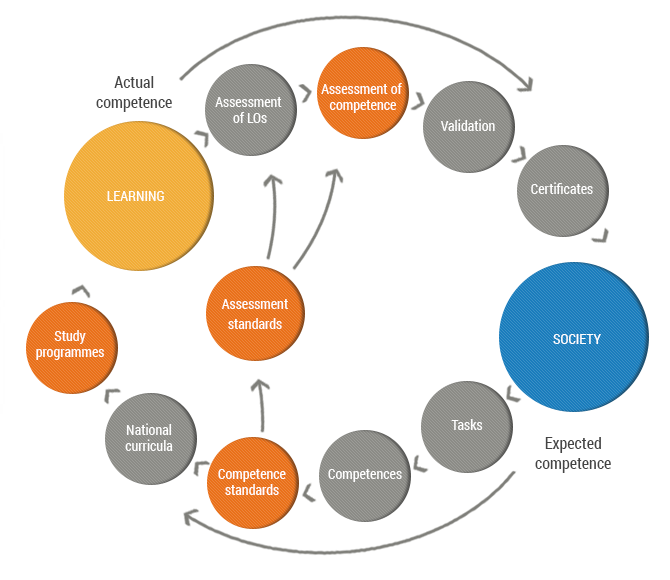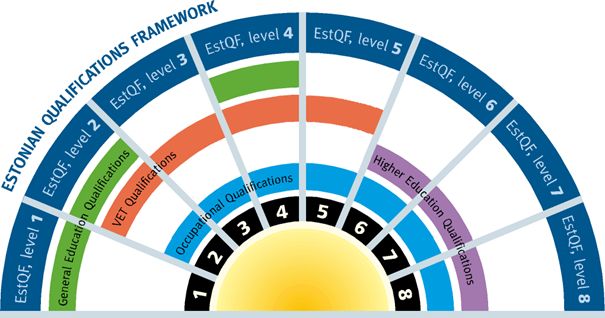Qualifications are divided as follows:
- formal education qualifications – general education (basic and upper secondary education), vocational education, higher education;
- professional qualifications, i.e. professions.
The part of a qualification subject to independent description and assessment is partial qualification. Partial qualifications are, for example, foreign language skills, a course in a subject, final paper, or partial profession. Partial qualifications are often obtained upon completing adult education courses.
Additional information
Formal education qualifications |
Level |
|
1 |
|
2 |
|
3 |
|
4 |
|
5 |
|
6 |
|
7 |
|
8 |
The professional qualifications system forms a part of the Estonian qualifications system. The professional qualifications system connects the education system with the labour market and contributes to lifelong learning and the development, assessment, recognition and comparison of work-related competence.
The objectives of the occupational qualifications system are:
- to support the competitive edge of the Estonian workforce - Estonian workforce is competent, they have the knowledge, skills and attitudes required for successful operation;
- to form prerequisites that the content and quantity of studies targeted at occupational activities meet requirements of the labour market;
- to facilitate that the competence of individuals is appreciated and recognised, regardless where and how the studies took place;
- to make occupational qualifications internationally comparable.
Parts of the system are:
- the system for the classification and cataloguing of occupational qualifications – catalogue of occupational qualifications
- the system of occupational qualification standards – occupational qualification standards
- the system for awarding professions – occupational qualification certificates
To bring the competence of graduates and employees into compliance with the requirements of the labour market, the professional qualifications system identifies the competence required for successful work in various roles of the professional area and a respective professional standard is drawn up for each of them. Professional standards help create possibilities for the assessment of competence, which is called the award of profession, and a respective training, in-service training and retraining system.
An important common part of the professional qualifications and education system is the system of education standards, the output of which is curricula.
Estonian qualifications have been arranged and can be compared in the Estonian Qualifications Framework (EstQF). The Estonian Qualifications Framework consists of eight levels and covers both formal education as well as professional qualifications.
Creation of the Estonian Qualifications Framework (EstQF) started in 2005, when the Minister of Education and Research established a broad-based working group with an assignment to analyse the first draft proposal of the European Qualification Framework for Lifelong Learning (EQF), the possibilities to link Estonian 5-levels occupational qualifications framework to the EQF, and formulate suggestions about the development of the EstQF.
The working group put forward the proposal of creating an 8-levels comprehensive national qualifications framework. The proposal was supported by the employers’ and employees’ organisations, by the Estonian Chamber of Commerce and Industry, by the Ministry of Social Affairs, and by the Ministry of Economic Affairs and Communications.
An eight-level EstQF was established in 2008, with the Occupational Qualifications Act The learning outcomes of each of these have been described in terms of levels:
- the learning outcomes of general education qualifications are described in national curricula for basic schools and upper secondary schools;
- the learning outcomes of vocational education are described in the vocational education standard;
- the learning outcomes of levels of higher education (professional higher education, Bachelor’s study, Master’s study and Doctoral study) are described in the higher education standard;
- competence requirements for professional qualifications, i.e. professions, are described in professional standards.
The descriptions of levels of the Qualifications Framework determine general requirements for learning outcomes of the education system and for professional levels of the professional qualifications system.
Estonian Qualifications Framework (EstQF) level descriptions
Referencing national qualifications to the European Qualifications Framework
When studying in a general education school, vocational school, institution of professional higher education or university in Estonia, one may think that the content of studies and the level of education are also understood well in other European countries – however, in reality this is not necessarily the case. In different countries vocational education alone comprises so many different types of study that it is very complicated to obtain an overview on them.
To make qualifications of different countries mutually more understandable and comparable, it is important that the Member States of the European Union create their own qualification frameworks. Although this is not obligatory, most of the EU Member States, incl. Estonia, have chosen such a way.
Referencing national qualifications and qualifications frameworks to the EQF is based on the best fit principle. This means reliable decision on what EQF level a particular qualification or NQF level fits best.
Because of the structure of the EQF level descriptors the application of this principle has two dimensions:
- the best fit with the EQF level description for a national qualification or a NQF level;
- the best fit with a particular EQF level descriptor (knowledge, skills and competence).
Implementation of the EQF is a voluntary undertaking based on mutual trust between the member states. The EQF Advisory Group has proposed 10 criteria and procedures for referencing the NQF levels to the EQF levels. These criteria and procedures serve as guidelines for the member states implementing the EQF. Following the criteria and procedures enables to do this in a transparent and coherent way.
Referencing of the EstQF to the EQF took place from December 2008 to August 2011. The creation and implementation of the EstQF is based on the principles for accountability and quality assurance of qualifications laid down by the European Parliament and Council recommendation on establishment of the EQF.
Since 2011 Estonian qualifications have been connected with levels of the European Qualifications Framework
As the descriptions of the levels of the Estonian Qualifications Framework (EstQF) are identical with the descriptions of the levels of the European Qualifications Framework (EQF), a level of the EstQF is always equal to the same level of the EQF.
The National Coordination Point (NCP) for the application of the Qualification Framework in Estonia is the Estonian Qualifications Authority
Academic recognition
Academic recognition is the recognition of a foreign qualification for the purpose of further studies.
In academic recognition, the evaluators mainly seek to assess whether the applicant is capable of continuing studies in the chosen direction and at the chosen level.
The need for academic recognition may arise when a person holds a diploma of the home country and seeks admission to a further stage of studies in a foreign country or seeks admission to further studies in the home country after completion of the previous stage or period of studies abroad.
On principle, academic recognition is only sought for admission to further studies. Some applicants, however, choose to receive a statement of academic recognition before seeking employment in the professions where recognition of a foreign degree/diploma is not officially required (i.e. in non-regulated professions). This kind of recognition (academic recognition for professional purposes) helps employers understand what the home country's qualification is compared to the foreign one.
In Estonia, the Academic Recognition Information Centre (Estonian ENIC/NARIC) is responsible for academic recognition.
EU recognition of professional qualifications
Any national of a member state of the European Union (EU), European Economic Area (EEA) or Switzerland has the right to work, seek work, set up business or provide services in any other member state.
Directive 2005/36 is in place to aid mobility between the member states of the EU, EEA and Switzerland. This directive applies to regulated professions including sectoral and general systems. The Directive works on the principle that a qualified professional in one member state is qualified to exercise the same profession in another member state. In order to work in a regulated profession with foreign qualifications, one must apply for the recognition of these qualifications by a competent authority.
Information about regulated professions, competent authorities and application procedures, etc. in a certain country is provided by the contact points for professional recognition.
Additional information
- Explanatory memorandum of the Directive
- Ministry of Education and Research: Tiia Raudma, tiia.raudma@hm.ee
- Estonian ENIC/NARIC Office
Last updated: 17.10.2022




